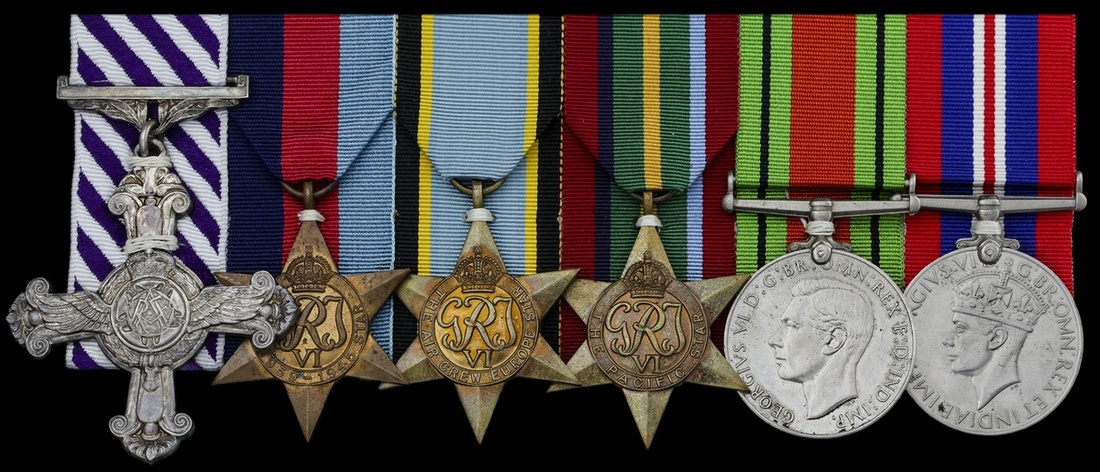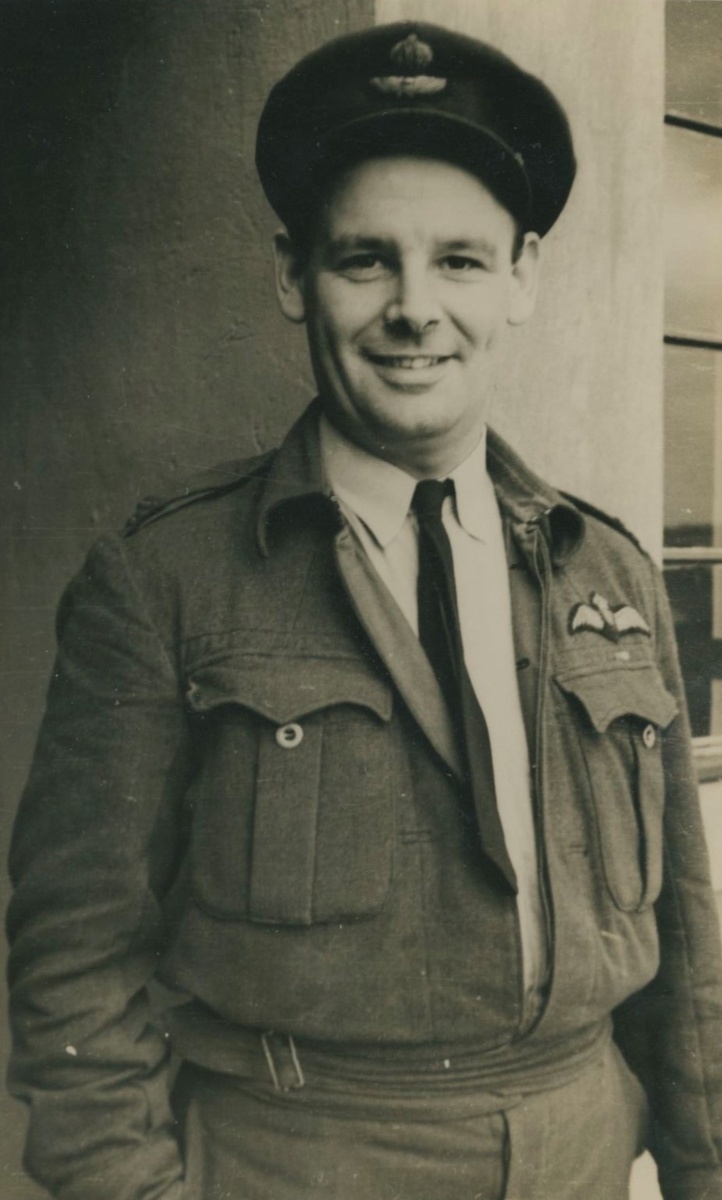Auction: 19002 - Orders, Decorations and Medals
Lot: 407
The outstanding Second World War Dieppe Raid D.F.C. group of six awarded to Squadron Leader R. B. Newton, Royal Air Force Volunteer Reserve
Having honed his skills in Spitfires of No. 72 Squadron and No. 403 (Canadian) Squadron in the period February 1941 to February 1942, a period in which he flew countless cross-Channel operational sorties, Newton was appointed to the command of No. 411 (Canadian) Squadron
And he was likewise employed at the time of the famous Dieppe Raid on 19 August 1942, when he led his pilots on four separate offensive sweeps over the embattled town, on one occasion participating in a 30-minute dogfight with 120 Fw. 190s and sharing in the destruction of one of them: one of his clashes with the enemy that day is preserved on gun camera footage held at the Imperial War Museum in London
Distinguished Flying Cross, G.VI.R., the reverse officially dated '1942'; 1939-45 Star; Air Crew Europe Star; Pacific Star; Defence and War Medals 1939-45, good very fine (6)
D.F.C. London Gazette 29 September 1942. The original recommendation states:
'Squadron Leader Newton has taken part in over 60 offensive operations over enemy territory and the Channel. He has destroyed one enemy aircraft, shared in another, probably destroyed two and damaged one.
He has commanded No. 411 Squadron since 2 August 1942; he led the Squadron in the recent operations over Dieppe, during which he shared in the destruction of an enemy aircraft. This recommendation for a decoration is based not on his 'score' but on his zeal, courage and leadership in offensive operations, and particularly his leadership of his squadron during the Dieppe operations.'
Robert Buckley Newton enlisted in the Royal Air Force in September 1939 and commenced pilot training at Prestwick in June 1940. 'Wings' up and commissioned, he was posted to No. 57 O.T.U. at Hawarden, where he converted to Spitfires, prior to joining No. 72 Squadron at Acklington in February 1941.
No. 72 Squadron - first blood
Having then participated in numerous operational patrols off the coast - and in convoy patrols - he moved south with the Squadron to Gravesend in the first week of July 1942. A few days later, with Biggin Hill as their forward base, the pilots of No. 72 commenced a flurry of cross-Channel sorties to Northern France; three of them were shot down in the unit's first encounter with the enemy on the 10th.
In fact Newton's flying log book bears grim testament to many such encounters - and resultant losses - in the period leading up to September. On the 17th, he attempted to establish the fate of a fellow pilot - L. B. F. 'Fordy' Fordham - whose Spitfire had been hit by flak over Calais. He lost him in the cloud but later discovered he had drowned off Dunkirk. A few days later - on the 23rd - he saw another comrade go down in flames and himself engaged a 109. The very next day his own Spitfire was hit during a 10-minute dogfight with a 109 and he had to make a deck-level retreat with his adversary pursuing him half-way across the Channel.
Sweeps to such places as St. Omer and Lille continued apace in August, Newton getting in hits on a 109 on the 12th: 'Observed pieces fly off his tail. Broke off at 2,000 feet, 109 still going straight down' (his flying log book, refers). Then on the 29th, No. 72 encountered swathes of 109s: 'More opposition than ever before. Attacked 3. No results. Terrific party … Sky full of Huns' (ibid).
No. 403 Squadron - Flight Commander - mounting score
By now regularly assessed as an 'above average' pilot, Newton was posted as a Flight Commander to No. 403 (Canadian) Squadron at Debden, from whence he continued to fly a hectic agenda of cross-Channel sweeps.
On the 27 September 1941, he and his fellow pilots were jumped by 'many 109s' just after crossing the enemy coast. Newton engaged three of them and 'got 1 in flames' (ibid). In the following month, the Squadron took up convoy patrol duties, Newton getting in some hits on a Dornier 215 off Orfordness on 25 November.
At the month's end, however, and possibly due to popular demand, he rejoined No. 72 as a Flight Commander at Gravesend. A mixture of Channel sweeps and convoy patrols ensued, although it was not until better weather in the new year that the agenda picked-up.
No. 411 Squadron - C.O.
In early February 1942, in the acting rank of Squadron Leader, Newton was appointed C.O. of another Spitfire unit, No. 411 (Canadian) Squadron, at Hornchurch. He was quickly back in action, flying a 'Roadstead' to the Dunkirk-Ostend sector on the 13th - amidst heavy flak, he damaged an E-Boat. One of his Sergeant Pilots was killed. Then on the 28th, after a collision with Flight Sergeant Gridley, he somehow coaxed his damaged Spitfire back to Manston for a belly-landing: 'Both O.K. but I was scared! Poor old 'B' written off' (ibid).
March witnessed further sweeps, including a costly outing over St. Omer on the 24th:
'411 bounced circa St. Omer. No top cover. Got short burst at 190 nearly head on. Sills, Ash, Gridley missing. Individual fights. Self bounced 3 times on way out. Landed Manston, 5 gallons' (ibid).
In another sweep - to Ostend on the 27th - Newton had a 'squirt' and three more enemy aircraft and raised his operational flying total to nearly 160 hours. Then in April - on the 15th - he scored a spectacular victory over Desvres:
'Dived at 580 m.p.h. (True) from 15,000 feet to 2,000 feet after FW. 190 (Flamer). Pulled out, + 9G, approx. 30 feet above sea' (ibid).
In May-July, in addition to ongoing cross-Channel sweeps, No. 411 carried out numerous patrols off Skegness, Newton damaging a Ju. 88 on 21 May.
The greatest air battle - Dieppe - D.F.C.
By now a veteran of over 60 cross-Channel operations, Newton was on the eve of winning his D.F.C., for, in August 1942, he led his squadron on no less than four trips to Dieppe during the famous raid on the 19th.
On the first of those sorties, his flying log book refers to a 'terrific battle' of 30 minutes duration with 120 Fw. 190s, one of which fell to his guns. But for a better understanding of No. 12 Group's part in this operation, we quote The Greatest Air Battle, by Norman Franks:
'Wing Commander Pat Jameson's 12 Group Wing from West Malling, comprising three Spitfire squadrons, were flying low towards Dieppe. Jameson was leading 485 New Zealand Squadron, commanded by Squadron Leader R. J. C. 'Bob' Grant, D.F.M., 411 Squadron as the middle squadron commanded by Squadron Leader R. B. Newton, plus 610 Squadron led by Squadron Leader J. E. 'Johnny' Johnson, D.F.C. as top cover. Up above all was Squadron Leader 'Raz' Berry's 81 Squadron from Fairlop. They would all meet Focke Wulfs. The Wing raced above the wavetops at zero feet then, nearing the hostile smoke covered shore, began to climb. Bob Grant had taken his New Zealanders up to between 3,000 and 4,000 feet when they arrived over the ships at 8.15 a.m. Above them they could see many enemy fighters. Robert Newton too saw many enemy fighters above, noticing that the Wing was greatly outnumbered by the 190s … Ranging from ground level to 20,000 feet and having a diameter of 25 miles, the air battle drifted and eddied over the coast and inland. The Wing had lost its cohesion but 36 Spitfires, or what was left of them, still carried out their task by fighting in pairs and fours and so achieved some concentration in the target area …'
Norman Franks continues:
'Immediately below 610's battle, Newton's Canadians too were hotly engaged by the enemy fighters. Pilot Officer Reid's machine was hit by cannon and machine-gun fire but he - Red 4 - returned safely. Red 3, Pilot Officer P. R. Eakins was seen to be hit by cannon fire which blew off his Spitfire's radiator. He failed to return. Pilot Officer D. Linton - Red 2 - was last seen going after a German fighter and he too failed to get back to West Malling. Red Leader, Robert Newton, got in a telling burst at a 190 which was claimed as destroyed. Flight Lieutenant R. W. McNair also saw strikes on a 190 which he claimed as probably destroyed. Blue 4, Sergeant S. A. Mills, was hit and wounded in the head by shrapnel but got his machine home … '
This extraordinary battle over, Newton led his squadron back to West Malling to refuel and re-arm, an exercise he would repeat on three further occasions before the day was out. On the last of those - as cover for the withdrawal from the beaches - he encountered and damaged a Dornier 215.
He was awarded the D.F.C.
Subsequent wartime career
Rested in September 1942, when he was posted as Squadron Leader Tactics to No. 9 Group, Newton attended a refresher course at 61 O.T.U. and a Fighter Leaders' Course in the following year.
Next embarked for Australia, he took command of No. 54 Squadron at Darwin in the Northern Territories in January 1944 and it was in this capacity that he went on to see action against the Japanese. By way of example, he led his squadron's Spitfires in an attack on an enemy wireless station on Babar Island in mid-April 1944. He relinquished his command in July 1945.
Sold with the recipient's original R.A.F. Pilot's Flying Log Book (Form 414), covering the period June 1940 to April 1944, together with two Far East paper 'blood chits'; the whereabouts of the recipient's second log book remains unknown. Also sold with an Imperial War Museum DVD, containing gun camera footage of combats fought by the recipient on 15 April and 19 August 1942 (Dieppe).
Subject to 20% VAT on Buyer’s Premium. For more information please view Terms and Conditions for Buyers.
Sold for
£2,900
Starting price
£2500







